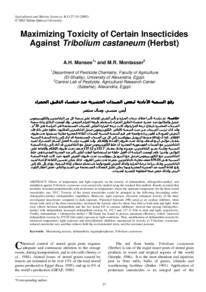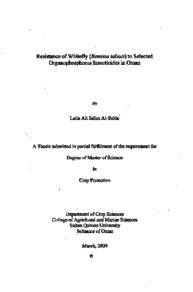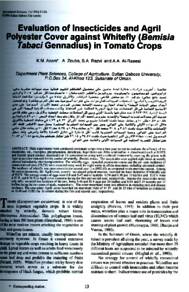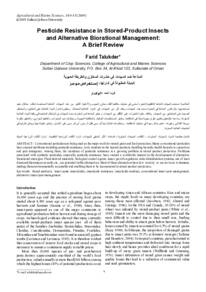وثيقة
(Maximizing toxicity of certain insecticides against tribolium castaneum (herbst.
المساهمون
Montasser, M.R., مؤلف
الناشر
Sultan Qaboos university
ميلادي
2003
اللغة
الأنجليزية
الملخص الإنجليزي
Effects of temperature and light exposure on the toxicity of deltamethrin, chlorpyrifos-methyl, and malathion against Tribolium castaneum were extensively studied using the residual film method. Results revealed that mortality increased proportionally with an increase in temperature, where the optimum temperature for the three tested insecticides was 30°C. Toxicity of the tested insecticides could be arranged in the following descending order: chlorpyrifos-methyl >deltamethrin >malathion. Moreover, light exposure obviously enhanced toxicity of the three investigated insecticides compared to dark exposure. Piperonyl butoxide (PB) acted as an oxidase inhibitor, when mixed with each of the three insecticides, increased the toxicity ratio by about four fold in both dark and light. Joint toxic effects between deltamethrin and the two tested OP as esterase inhibitors, showed that mixing chlorpyrifosmethyl with deltamethrin increased deltamethrin toxicity by 152.7 and 137.12 fold in dark and light, respectively. Finally, deltamethrin + chlorpyrifos-methyl + PB blend was found to possess maximum efficiency, which increased deltamethrin toxicity by 679.05 fold under exposure to light conditions. Thus, modification of deltamethrin toxicity by increased temperature; light exposure and detoxification inhibitors maximized its toxicity to Tribolium castaneum, reduced insecticide rate, and thus reduces both the environmental stress, and the resistance pressure.
المجموعة
ISSN
2410-1079
URL المصدر
zcustom_txt_2
Mansee, A. H., & . Montasser, M. R. (2003). Maximizing toxicity of certain insecticides against tribolium castaneum (herbst). Journal of Agricultural and Marian Sciences, 8 (1), 27-34.
الملخص العربي
تم دراسة تأثير اختلاف درجات الحرارة وتأثير التعرض للإضاءة على سمية كل من الدلتاميثرين والكلوربيريفوس - ميثيل والملاثيون ضد حشرة خنفساء الدقيق الحمراء باستخدام طريقة الفيلم المتبقي. وقد أوضحت النتائج زيادة سمية المبيدات المختبرة بارتفاع درجة الحرارة وقد كانت درجة الحرارة المثلى للمبيدات المستخدمة في الدراسة هي 30°م. وقد كان ترتيب المبيدات من حيث السمية كالتالي : الكلوربيريفوس - ميثيل الدلتاميثرين الملاثيون. علاوة على ذلك فإن التعرض للضوء قد أظهر زيادة واضحة في قيم السمية النسبية للمبيدات الثلاثة المختبرة مقارنة بسميتها تحت ظروف الإظلام. كما أن إضافة منشط الببرونيل بيوتوكسيد إلى كل من المبيدات المستخدمة قد أدى إلى زيادة السمية النسبية بمقدار حوالي أربعة أضعاف وذلك تحت ظروف الإضاءة والإظلام. وقد أظهرت دراسة الفعل السام المشترك لمبيد الدلتاميثرين مع المبيدات الفوسفورية المختبرة أن خلط الكلوربيريفوس - مينيل مع الدلتاميثرين قد أدى إلى زيادة السمية النسبية مقارنة بمبيد الدلتاميثرين بمفرده وذلك بمقدار 152.7 و 137.12 ضعف تحت ظروف الإظلام والإضاءة على التوالي. وأخيرا، فقد أوضحت الدراسة أن أفضل خلطة تم استخدامها أعطت أعلى تأثير ضد الحشرة المختبرة هي خلط الدلتاميثرين مع الكلوربيريفوس - ميتيل مع الببرونيل بيوتوكسيد تحت ظروف التعرض للضوء حيث كانت قيمة السمية النسبية هي 679.05 ضعف مقارنة بالدلتامترين بمفرده تحت نفس الظروف. لذلك يمكن تحسين الكفاءة الإبادية لمبيد الدلتاميثرين وذلك بزيادة درجة الحرارة وكذلك التعرض للضوء وأيضا باستخدام مثبطات إزالة السمية. يؤدي كل ذلك إلى رفع كفاءة المبيد ضد الحشرة المختبرة وبهذا يمكن تقليل المعدلات المستخدمة من المبيد وبالتالي خفض أخطار التلوث البيئي وكذلك خفض صفة المقاومة للحشرة للمبيدات.
قالب العنصر
مقالات الدوريات




